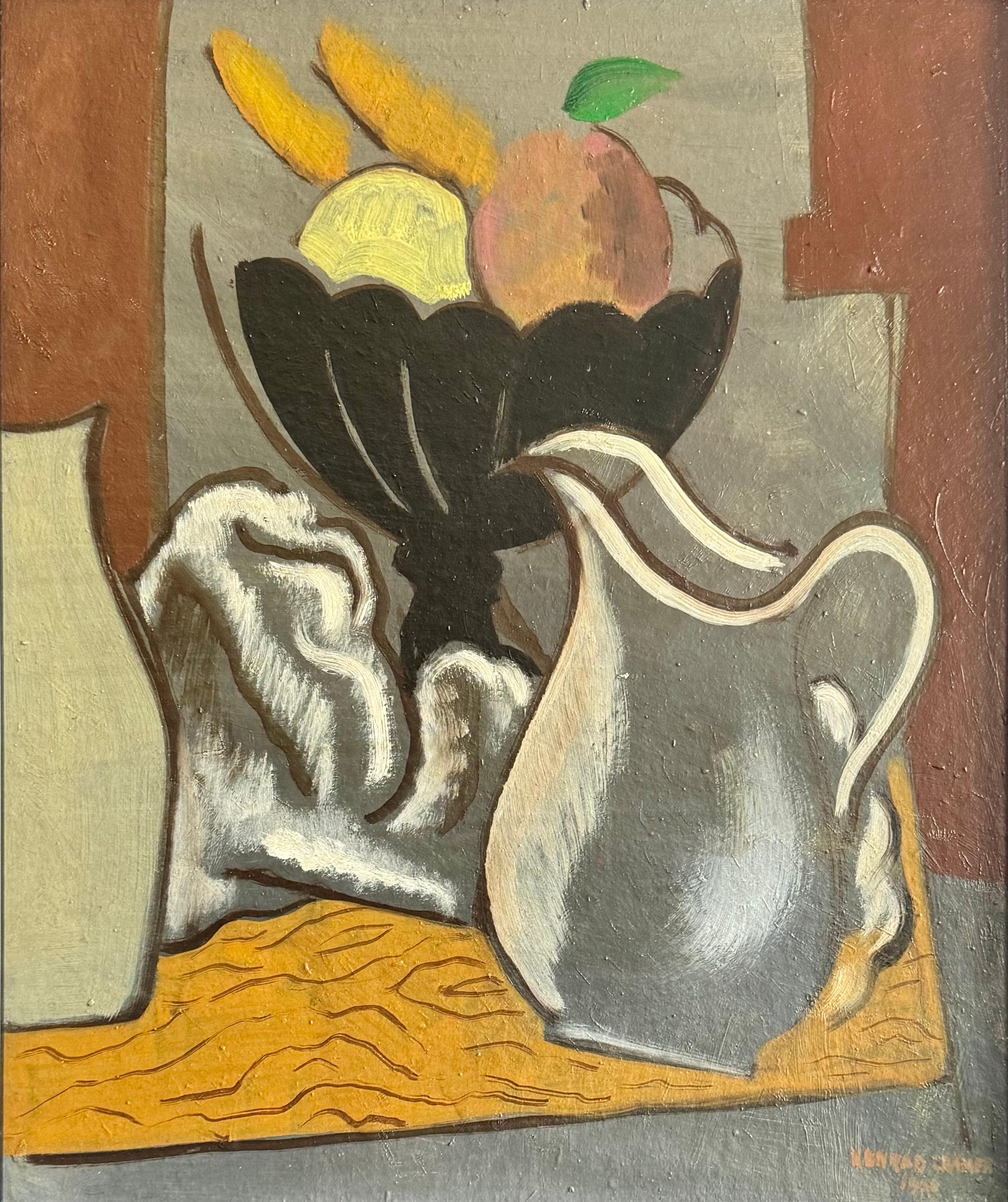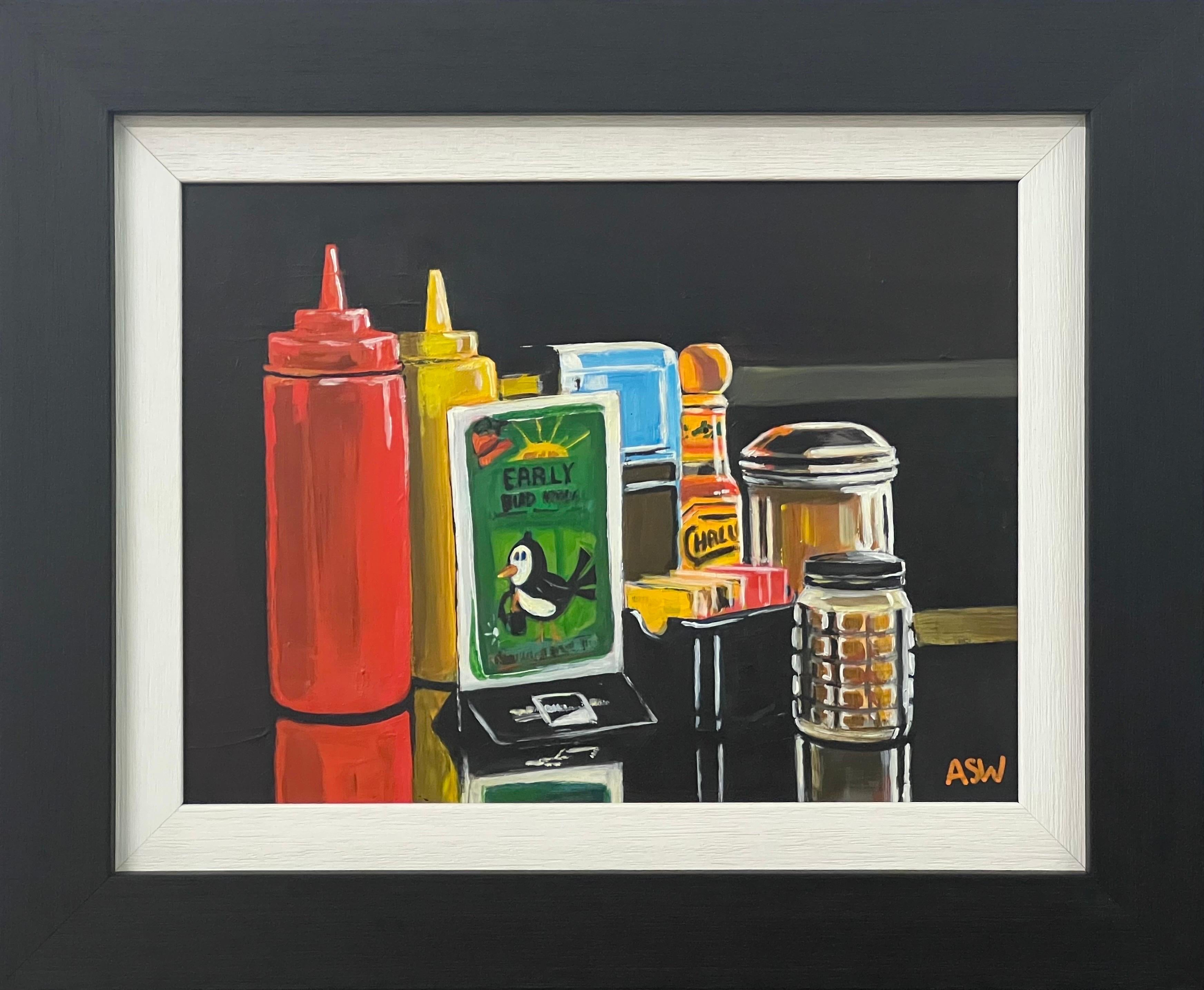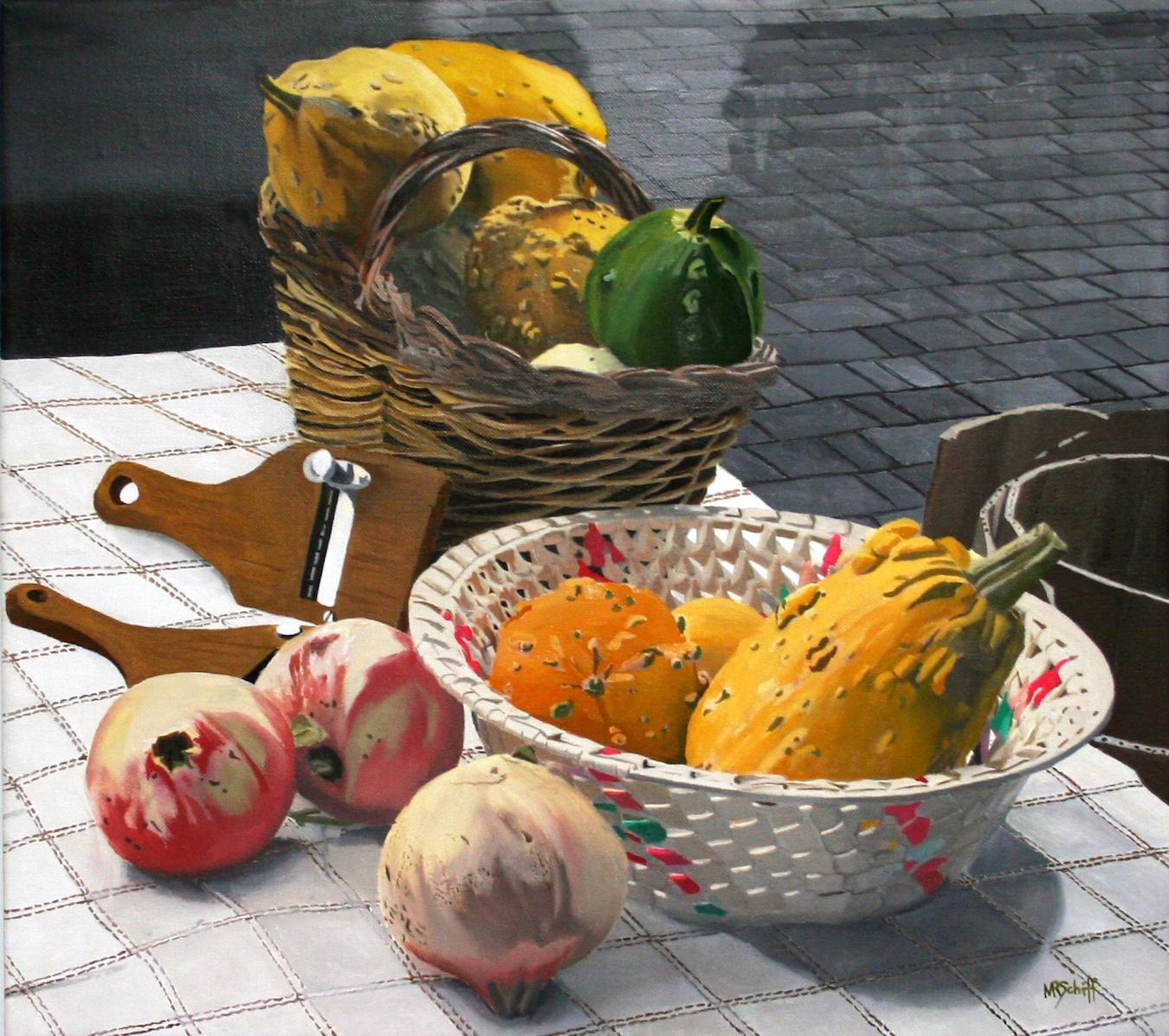Items Similar to Studio Interior Mid 20th Century American Scene Modern WPA Still Life Realism
Want more images or videos?
Request additional images or videos from the seller
1 of 8
Joseph SolmanStudio Interior Mid 20th Century American Scene Modern WPA Still Life Realismc. 1930s
c. 1930s
About the Item
Studio Interior Scene Mid 20th Century American Modern WPA Still Life Realism
The painting measures 10 x 12 inches. Framed, the work is 13 1/4 x 15 1/2 inches. c. 1930s
BIO
Brought to America from Russia as a child in 1912, Joseph Solman was a prodigious draftsman and knew, in his earliest teens, that he would be an artist. He went straight from high school to the National Academy of Design, though he says he learned more by sketching in the subway on the way back from school late at night: people “pose perfectly when they’re asleep.”
In 1929, Solman saw the inaugural show at the Museum of Modern Art featuring Seurat, Gauguin, Van Gogh, and Cezanne. It changed his life – and his art.
Joseph Solman was, with Mark Rothko, the unofficial co-leader of The Ten, a group of expressionist painters who exhibited as the “Whitney Dissenters” at the Mercury Galleries in New York in 1938. A champion of modernism, Solman was elected an editor of Art Front Magazine when its other editors, art historian Meyer Shapiro and critic Harold Rosenberg, were still partial to Social Realism
In 1964, The Times, discussing his well-known subway gouaches (done while commuting to his some-time job as a racetrack pari-mutuel clerk), called him a “Pari-Mutuel Picasso.” In 1985, on the occasion of a 50-year retrospective, The Washington Post wrote: “It appears to have dawned, at last, on many collectors that this is art that has already stood the acid test of time.”
We had the pleasure of the meeting the artist a few times at his home which was over the original Second Avenue Deli in the East Village.
- Creator:Joseph Solman (1909-2008, American)
- Creation Year:c. 1930s
- Dimensions:Height: 13.25 in (33.66 cm)Width: 15.25 in (38.74 cm)
- Medium:
- Movement & Style:
- Period:
- Condition:
- Gallery Location:New York, NY
- Reference Number:1stDibs: LU1156212698612
About the Seller
5.0
Platinum Seller
These expertly vetted sellers are 1stDibs' most experienced sellers and are rated highest by our customers.
Established in 2008
1stDibs seller since 2019
165 sales on 1stDibs
Typical response time: <1 hour
- ShippingRetrieving quote...Ships From: New York, NY
- Return PolicyA return for this item may be initiated within 3 days of delivery.
More From This SellerView All
- "Two Bottles" American Scene Realism Mid 20th Century Female Artist WPA 1940'sBy Helen Clark OldfieldLocated in New York, NY"Two Bottles" American Scene Realism Mid 20th Century Female Artist WPA 1940's Helen Clark Oldfield "Two Bottles," 1943. Signed “Helen Oldfield” lower right. Oil on canvas board, 18 x 14 inches. Provenance: Estate of the Artist. Helen Clark Oldfield was born in Santa Rosa. Her father, James E. Clark, invested in local hops farms. He was a director of the first Santa Rosa Bank. Oldfield lived at 547 Mendocino Avenue, in one of the finest custom-built homes in town. She was the oldest child of the family. They spent summers in their beach cabin at Jenner-by-the-Sea. She was a good student and graduated from DeWitt Montgomery High in Santa Rosa with college standard grades. Unfortunately, this idyllic situation tumbled down suddenly. due to a fraud scandal at the Bank, her father forfeited most of his assets in order to make good on his client's losses. At the time when her high school friends were going east to college, Oldfield followed her family to a new life of farming. She found this life frustrating as there was little time for her interests after conclusion of her daily duties. Here she developed her natural gift for sophisticated needle work. At the time she also took a correspondence course in industrial design and became an expert tailor. Her family was not happy with the farming arrangement. They decided to move to Oakland. In 1921 they purchased a home at 318...Category
1940s American Realist Still-life Paintings
MaterialsOil, Board
- Still Life American Scene Social Realism 20th Century Woodstock Modern DudensingBy Konrad CramerLocated in New York, NYStill Life American Scene Social Realism 20th Century Woodstock Modern Dudensing Konrad Cramer (1888 – 1963) "Black Glass Bowl and Napkin" 16 ½ x 14 inches Oil on Board Singed lower...Category
1920s American Realist Still-life Paintings
MaterialsBoard, Oil
- Art Deco Movie Set 20th Century American Modernism Hollywood WPA Social RealismLocated in New York, NYArt Deco Movie Set 20th Century American Modernism Hollywood WPA Social Realism Arthur Rosenman Ross (1913 - 1981) Art Deco Movie Set, Probably MGM Studios, 1937 17 x 27 inches Gouache on illustration Board Signed Art Ross, ‘37 lower right Provenance: Estate of the artist. BIO Arthur Rosenman Ross was a key figure in automotive design at General Motors during America's "Golden Age" of auto design, the 1930's through the 1950s. He attended the Art Institute of Chicago from age 17, exhibiting a special interest for automotive renderings and the female figure. In 1934, he changed his name from Rosenman to Ross, fearing his Jewish ancestry could prejudice his career prospects. At age 20, he turned down job offers from MGM Studios in Hollywood and Duesenberg to work at General Motors alongside the Legendary Harley Earl in 1935. He was hand picked by Mr. Earl and assigned to GM's War and Camouflage Division in 1937 through WW2. It was during this pivotal period in which he executed some extraordinary military aircraft artworks, likely used between GM and America's military aeronautics companies in design preparation for WW2. General Motors played an important role in helping America's aircraft manufacturers preceding and during the war. Just after the war in 1945, Mr. Ross was rewarded by GM, being made Chief Designer of Cadillac, then two years later becoming Chief at Oldsmobile until his retirement in 1959. He was in large part responsible for some of GM's classic Cadillac designs such as the Cadillac Sixty Special, Fleetwood, LaSalle and GM's first concept car, the extraordinary Buick Y-Job. Mr. Ross was an exceptionally charismatic and vivacious man who quite by chance, befriended His idol, Salvador Dali at GM in 1955. They talked about art, cars and girls late into the evening, according to his son, Carter Ross. He had a gift in rendering the erotic arts...Category
1930s Art Deco Interior Paintings
MaterialsBoard, Gouache
- Chess Players WPA Depression Era Mid-20th Century American Scene Realism ModernBy Mervin JulesLocated in New York, NYChess Players WPA Depression Era Mid-20th Century American Scene Realism Modern. Signed upper right and verso 8 x 10 inches oil on board. BIO The son of a men's haberdasher, Mervin ...Category
1930s American Realist Figurative Paintings
MaterialsOil, Board
- "A Marro" WPA Mid 20th Century American Scene Social Realism Modernism AshcanBy Daniel Ralph CelentanoLocated in New York, NY"A Marro" WPA Mid 20th Century American Scene Social Realism Modernism Ashcan. Signed lower right. Verso, label of Walker Galleries New York and signed in pencil and titled, A Marro....Category
1930s American Realist Figurative Paintings
MaterialsBoard, Oil
- Men Working Mural Study American Scene Social Realism Mid 20th Century ModernBy Jo CainLocated in New York, NYMen Working Mural Study American Scene Social Realism Mid 20th Century Modern Jo Cain (1904 – 2003) Men Working: WPA Mural Study 17 ½ x 10 ½ inches Oil on ...Category
1940s American Realist Figurative Paintings
MaterialsOil, Board
You May Also Like
- Art Shipping and Receiving, Photorealist Oil Painting on Board by Harry LaneBy Harry LaneLocated in Long Island City, NYArtist: Harry Lane Title: Art Shipping and Receiving Year: Circa 1950 Medium: Oil on Board, signed lower right Size: 30 in. x 24 in. (76.2 cm x 60.96 cm) ...Category
1950s American Realist Interior Paintings
MaterialsBoard, Oil
- An American Still Life of an Apple, Pear and Grapes circa 1880sLocated in SANTA FE, NMAn American Still Life of an Apple, Pear and Grapes Oil on canvas on board Signed illegibly circa late 1800s 9 3/4 x 5 7/8 (16 x 12 3/4 frame) inches This is an example of late 19...Category
Late 19th Century American Realist Still-life Paintings
MaterialsCanvas, Oil, Board
- Americana Still Life Painting of American Diner Table Condiments & Sauces ArtBy Angela WakefieldLocated in Preston, GBAmericana Still Life Painting of American Diner Table Condiments & Sauces Art by Leading British Urban Painter, Angela Wakefield Art measures 12 x 9 inches Frame measures 17 x 14 in...Category
2010s American Realist Still-life Paintings
MaterialsGesso, Paint, Varnish, Mixed Media, Oil, Acrylic, Board
- GourdsBy Mark SchiffLocated in Boca Raton, FLGourds by Mark Schiff We guarantee that you will love this painting. If not, you can return it for a complete refund, no questions asked.Category
Early 2000s American Realist Still-life Paintings
MaterialsCanvas, Oil
- Sweet and SourBy Mark SchiffLocated in Boca Raton, FLSweet and Sour by Mark Schiff We guarantee that you will love this painting. If not, you can return it for a complete refund, no questions asked.Category
Early 2000s American Realist Still-life Paintings
MaterialsCanvas, Oil
- Jim's Steaks -- Original Oil Painting -- Please watch attached videoBy Mark SchiffLocated in Boca Raton, FLPlease see accompanying video. We are a 1stdibs Platinum Seller with 100% 5-star reviews. One cannot appreciate this painting on a computer screen; in real life, it is absolutely amazing. Because you cannot appreciate it on a computer screen, our gallery has a unique policy. When purchasing from us, the buyer has sixty days to determine if they want to keep the artwork. If not, the buyer returns to piece to us for full refund, and we pay the shipping both ways! A collector should consider several factors when deciding from whom to purchase artwork online. Check the location of the seller. When one buys from a foreign seller, one also has to consider the problems of getting the piece through Customs. There are often delays and considerable fees to pay in order to import the item. When purchasing from us, we ship the same day and you receive it via FedEx the next day, no problems or hassles. When one purchases from an auction house, one pays a buyer’s premium of anywhere from 23% to 28% over the “hammer price”. So when one “wins” an auction for $20,000, the actual price paid is more like $25,000. By contrast, when purchasing from us, the price agreed to is the price paid by the buyer, no hidden fees. Secondly, when one purchases from an auction house, the buyer pays the packing and shipping fee, which are usually exorbitant. By contrast, when purchasing from us, the price includes packing and shipping. Thirdly, when one purchases from an auction house, the sale is final. If one receives the piece and is not 100% satisfied with it, there is nothing the buyer can do about it. They are stuck with it. By contrast, when purchasing from us, the buyer has sixty days to determine if they want to keep it. If not, the buyer returns to piece to us for full refund, and we pay the shipping both ways. About Mark Schiff — Animated by photographs that reflect his personal life, Mark Schiff’s paintings are fueled by what makes him happy. Through his open touch and signature blending method, he lends his artistic perception to the original photographic compositions captured on his Leica. Mark’s creative vision has been alive since he was a boy. As a child he spent his summers observing life as he rode the trolley back and forth to art classes at the Pratt Institute. During his future travels to Europe, Mark’s eye for light and photography merged with his passion for painting at the Jeu de Paume in Paris; which triggered his career in photorealism. Mark is well known for painting objects that people can identify and emotionally connect with. His work is distinctly marked by a rich palette and the luminous range of light he paints into his compositions. Each painting is a true extension of his vision and can take up to 200 hours to complete. Mark Schiff’s work has been commissioned by the well-known brands The Hershey Company and Tropicana. His private collectors include A-list celebrities and also corporate collectors in the US and abroad. Possessing a strong philanthropic nature, Mark donates both his time and works to charitable organizations such as Big Brothers Big Sisters, The Ronald McDonald House, Make-A-Wish Foundation, The Humane Society and the Special Olympics. Photorealism is widely viewed as one of this century’s most exciting genres of art. When a photorealistic painting is viewed from afar, it looks like a photograph. Only when getting very close to the art does the viewer realize that it is in fact not a photo, but rather an oil painting. Photorealism can also refer to sculptures. Duane Hanson is known as the greatest photorealistic sculptor of all time. Some of the greatest photorealistic painters include Mark Schiff, Richard Estes, Ralph Goings, Charles Bell and Audrey Flack. Photorealist Mark Schiff was born in Bedford Stuyvesant, Brooklyn, in a neighborhood known as a kuchalane, a Yiddish word which Schiff defines as a place where everyone (from the Old Country) ended up living on the same street, and most likely knowing each other’s business. His Russian grandfather came to the US before the revolution and both his parents were first generation American. Even at five years of age, Mark showed exceptional talent. In the summer, his mother permitted him to travel by himself on the trolley for art classes at the Pratt institute. He continued studying there until he was eleven and the family moved to Great Neck. Except for a few art classes in high school and playing baritone horn in the band, Mark focused on other things besides art, especially when his mother worried for his financial future, kept insisting “that Jewish boys don’t starve to death.” His father made a good living as a production man in textiles so Mark, who had spent years doing the rounds of knitting mills with his father, decided to major in textile chemistry at North Carolina State. ROTC was mandatory on his campus and he did two years in order to be eligible for officer status. He won the Armed Forces Chemical Association award and thought for sure that he would be assigned chemical work, but instead was made a tank commander and stationed at Fort Knox. Not exactly what his heart yearned for, but a good job awaited him at Sandoz, a Swiss company that made dyestuff. What perfect training for someone who would soon be working in wonderful rich colors on canvas. He went on to receive his MBA degree from Hofstra University, left Sandoz and was hired to sell at a spinning mill. He liked it. In 1976 he joined Bennett Berman Associates and had an opportunity to buy the spinning mill Spun Fibers. But what of art? In the early days, Elsie, his wife of fifty-two years, had a problem with the large amount of space his canvases occupied in their one bedroom apartment. Mark took up photography instead, which only required a small darkroom. Photography was a natural ally for his eventual return to painting in the photorealistic style. It was on his second trip to Europe that Mark fell in love with painting all over again. The impressionistic museum, Jeu de Paume in Paris, renewed his passion and it’s been non-stop since then. Out came the brushes, but this time, he used his love and skill of photography, and built a style based on the photographs he had taken, bringing them to life with paint. Mark was still not painting to sell until in 1990 when someone discovered and desperately wanted his candy bar (Sweet Series) painting. Mark didn’t want to let go of that particular piece, but was finally convinced to sell it and a second candy painting to this ardent art and candy lover. Two years later, Mark was commissioned to make three paintings of this man’s new Ferrari. Some of the artists who have inspired his work are Richard Estes, Sandy Scott, Chuck Close, and Charles Bell. He appreciates the work of Ken Keeley, but unlike Keeley’s hard-lined/tape and ruler style, Mark prefers an open touch, using the blending method. Mark’s subject matters range from candy bars to spice racks to soda cans and soda bottles. He photographs with a Leica M-7 and each painting can take up to 200 or more hours to complete. His palette is rich; his subjects, be it a fire engine or a pretzel cart, take on a luminous quality, always photoreal, but even more beautiful. Mark developed his own technique for working with bottles by painting a canvas all black, so that the transparency of the bottles allows a wonderful range of light to filter through. The same light and reflection can be seen in the black rotary phone...Category
Early 2000s American Realist Still-life Paintings
MaterialsCanvas, Oil




